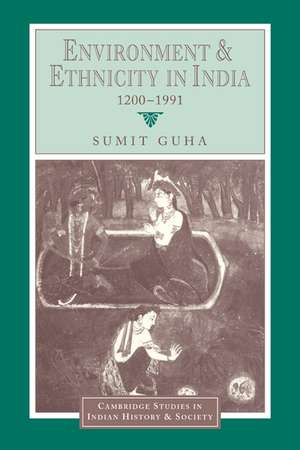Environment and Ethnicity in India, 1200–1991: Cambridge Studies in Indian History and Society, cartea 4
Autor Sumit Guhaen Limba Engleză Paperback – noi 2006
| Toate formatele și edițiile | Preț | Express |
|---|---|---|
| Paperback (1) | 390.64 lei 6-8 săpt. | |
| Cambridge University Press – noi 2006 | 390.64 lei 6-8 săpt. | |
| Hardback (1) | 734.72 lei 6-8 săpt. | |
| Cambridge University Press – 14 iul 1999 | 734.72 lei 6-8 săpt. |
Din seria Cambridge Studies in Indian History and Society
-
 Preț: 284.98 lei
Preț: 284.98 lei -
 Preț: 403.33 lei
Preț: 403.33 lei -
 Preț: 207.91 lei
Preț: 207.91 lei -
 Preț: 319.99 lei
Preț: 319.99 lei -
 Preț: 323.00 lei
Preț: 323.00 lei -
 Preț: 293.17 lei
Preț: 293.17 lei -
 Preț: 299.44 lei
Preț: 299.44 lei -
 Preț: 376.82 lei
Preț: 376.82 lei -
 Preț: 284.01 lei
Preț: 284.01 lei -
 Preț: 308.88 lei
Preț: 308.88 lei -
 Preț: 285.93 lei
Preț: 285.93 lei -
 Preț: 209.65 lei
Preț: 209.65 lei -
 Preț: 320.55 lei
Preț: 320.55 lei -
 Preț: 286.30 lei
Preț: 286.30 lei -
 Preț: 284.56 lei
Preț: 284.56 lei -
 Preț: 322.51 lei
Preț: 322.51 lei -
 Preț: 418.39 lei
Preț: 418.39 lei -
 Preț: 417.07 lei
Preț: 417.07 lei -
 Preț: 427.94 lei
Preț: 427.94 lei -
 Preț: 367.96 lei
Preț: 367.96 lei -
 Preț: 349.20 lei
Preț: 349.20 lei - 11%
 Preț: 552.73 lei
Preț: 552.73 lei
Preț: 390.64 lei
Nou
Puncte Express: 586
Preț estimativ în valută:
74.77€ • 77.05$ • 63.12£
74.77€ • 77.05$ • 63.12£
Carte tipărită la comandă
Livrare economică 03-17 martie
Preluare comenzi: 021 569.72.76
Specificații
ISBN-13: 9780521028707
ISBN-10: 0521028701
Pagini: 236
Ilustrații: 4 maps 4 tables
Dimensiuni: 152 x 228 x 15 mm
Greutate: 0.36 kg
Editura: Cambridge University Press
Colecția Cambridge University Press
Seria Cambridge Studies in Indian History and Society
Locul publicării:Cambridge, United Kingdom
ISBN-10: 0521028701
Pagini: 236
Ilustrații: 4 maps 4 tables
Dimensiuni: 152 x 228 x 15 mm
Greutate: 0.36 kg
Editura: Cambridge University Press
Colecția Cambridge University Press
Seria Cambridge Studies in Indian History and Society
Locul publicării:Cambridge, United Kingdom
Cuprins
'Rama, Sita and Lukshmana in the forest'; List of maps; List of tables; Acknowledgements; Glossary; List of abbreviations; Introduction; 1. From the archaeology of mind to the archaeology of matter; 2. Subsistence and predation at the margins of cultivation; 3. State formation in the highland forests, 1350–1800; 4. The peoples of the Sahyadri under Marathas and British; 5. The central Indian forest from Mughal suzerainty to British control; 6. The central Indian forest under early British rule; 7. Identity and aspiration: not noble savage but savage noble; 8. The high colonial period and after: new patterns of authority and power; 9. From sanctuaries to safeguards: policies and politics in twentieth-century India; Conclusion; Afterword; Bibliography; Index.
Recenzii
"...a significant contribution to knowledge of a heretofore thinly researched aspect of South Asian history and development." Choice
"...this book is a major contribution to the historiography of South Asia." The Historian
"...this book is a major contribution to the historiography of South Asia." The Historian
Descriere
An analysis of environment and ethnicity through the history of forest communities in western India, first published in 1999.















